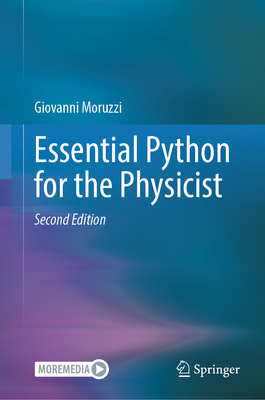Introduction to Numerical Programming: A Practical Guide for Scientists and Engineers Using Python and C/C++ (Hardcover)
暫譯: 數值程式設計入門:科學家與工程師的實用指南,使用 Python 和 C/C++ (精裝版)
Titus A. Beu
買這商品的人也買了...
-
 大話設計模式
大話設計模式$620$490 -
 深入淺出 JavaScript (Head First JavaScript)
深入淺出 JavaScript (Head First JavaScript)$880$695 -
 重構─改善既有程式的設計, 2/e (Refactoring: Improving The Design of Existing Code)
重構─改善既有程式的設計, 2/e (Refactoring: Improving The Design of Existing Code)$800$632 -
 $738Digital Image Processing, 3/e (IE-Paperback)
$738Digital Image Processing, 3/e (IE-Paperback) -
 智慧型機器人程式開發與實作
智慧型機器人程式開發與實作$490$387 -
 Robot Development Using Microsoft Robotics Developer Studio (Hardcover)
Robot Development Using Microsoft Robotics Developer Studio (Hardcover)$1,250$1,225 -
 Android App 程式設計教本之無痛起步, 2/e
Android App 程式設計教本之無痛起步, 2/e$480$408 -
 SQL Server 效能調校
SQL Server 效能調校$450$351 -
 ASP.NET MVC 5 網站開發美學
ASP.NET MVC 5 網站開發美學$780$616 -
 實戰 Wireshark|網路分析其實很簡單
實戰 Wireshark|網路分析其實很簡單$450$356 -
 精實開發與看板方法
精實開發與看板方法$550$435 -
 24 小時不打烊的雲端服務:專家教你用 Windows Server 2012 R2 Hyper-V3 叢集雲端架構實戰 (高級篇)
24 小時不打烊的雲端服務:專家教你用 Windows Server 2012 R2 Hyper-V3 叢集雲端架構實戰 (高級篇)$580$452 -
 JavaScript & jQuery: The Missing Manual, 3/e (國際中文版)
JavaScript & jQuery: The Missing Manual, 3/e (國際中文版)$680$537 -
 Docker 入門與實戰
Docker 入門與實戰$450$356 -
 ASP.NET MVC 5 實務專題範例教學
ASP.NET MVC 5 實務專題範例教學$590$502 -
 Agile 學習手冊 | Scrum、XP、精實和看板方法 (Learning Agile: Understanding Scrum, XP, Lean, and Kanban)
Agile 學習手冊 | Scrum、XP、精實和看板方法 (Learning Agile: Understanding Scrum, XP, Lean, and Kanban)$680$537 -
 AngularJS 必學的 90 項實務秘方(AngularJS Web Application Development Cookbook)
AngularJS 必學的 90 項實務秘方(AngularJS Web Application Development Cookbook)$420$328 -
 R 軟體資料分析基礎與應用 (R for Everyone: Advanced Analytics and Graphics)
R 軟體資料分析基礎與應用 (R for Everyone: Advanced Analytics and Graphics)$650$553 -
.jpg) 統計學,最強的商業武器:實踐篇
統計學,最強的商業武器:實踐篇$380$300 -
 大話重構
大話重構$390$304 -
 Microsoft Azure 教戰手札 – 系統建置與管理篇, 3/e
Microsoft Azure 教戰手札 – 系統建置與管理篇, 3/e$550$435 -
 正確學會 Dreamweaver CC 的 16 堂課
正確學會 Dreamweaver CC 的 16 堂課$520$442 -
 鳥哥的 Linux 私房菜-基礎學習篇, 4/e
鳥哥的 Linux 私房菜-基礎學習篇, 4/e$980$774 -
 Python 程式設計「超入門」
Python 程式設計「超入門」$420$357 -
 FinTech 金融科技聖經 — 全球 86位 FinTech 先驅,第一手公開「金融科技做什麼?怎麼做?」
FinTech 金融科技聖經 — 全球 86位 FinTech 先驅,第一手公開「金融科技做什麼?怎麼做?」$480$408
相關主題
商品描述
Makes Numerical Programming More Accessible to a Wider Audience
Bearing in mind the evolution of modern programming, most specifically emergent programming languages that reflect modern practice, Numerical Programming: A Practical Guide for Scientists and Engineers Using Python and C/C++ utilizes the author’s many years of practical research and teaching experience to offer a systematic approach to relevant programming concepts. Adopting a practical, broad appeal, this user-friendly book offers guidance to anyone interested in using numerical programming to solve science and engineering problems. Emphasizing methods generally used in physics and engineering—from elementary methods to complex algorithms—it gradually incorporates algorithmic elements with increasing complexity.
Develop a Combination of Theoretical Knowledge, Efficient Analysis Skills, and Code Design Know-How
The book encourages algorithmic thinking, which is essential to numerical analysis. Establishing the fundamental numerical methods, application numerical behavior and graphical output needed to foster algorithmic reasoning, coding dexterity, and a scientific programming style, it enables readers to successfully navigate relevant algorithms, understand coding design, and develop efficient programming skills. The book incorporates real code, and includes examples and problem sets to assist in hands-on learning.
- Begins with an overview on approximate numbers and programming in Python and C/C++, followed by discussion of basic sorting and indexing methods, as well as portable graphic functionality
- Contains methods for function evaluation, solving algebraic and transcendental equations, systems of linear algebraic equations, ordinary differential equations, and eigenvalue problems
- Addresses approximation of tabulated functions, regression, integration of one- and multi-dimensional functions by classical and Gaussian quadratures, Monte Carlo integration techniques, generation of random variables, discretization methods for ordinary and partial differential equations, and stability analysis
This text introduces platform-independent numerical programming using Python and C/C++, and appeals to advanced undergraduate and graduate students in natural sciences and engineering, researchers involved in scientific computing, and engineers carrying out applicative calculations.
商品描述(中文翻譯)
使數值程式設計對更廣泛的受眾更具可及性
考慮到現代程式設計的演變,特別是反映現代實踐的新興程式語言,《數值程式設計:科學家和工程師使用 Python 和 C/C++ 的實用指南》利用作者多年來的實踐研究和教學經驗,提供了一種系統化的方法來理解相關的程式設計概念。這本以實用性和廣泛吸引力為導向的用戶友好書籍,為任何有興趣使用數值程式設計解決科學和工程問題的人提供了指導。強調在物理和工程中普遍使用的方法——從基本方法到複雜算法——它逐步引入具有日益複雜性的算法元素。
發展理論知識、有效分析技能和程式設計專業知識的結合
本書鼓勵算法思維,這對數值分析至關重要。建立所需的基本數值方法、應用數值行為和圖形輸出,以促進算法推理、編碼靈活性和科學程式設計風格,使讀者能夠成功導航相關算法,理解編碼設計,並發展有效的程式設計技能。本書包含實際代碼,並提供範例和問題集以協助實作學習。
- 開始於對近似數字和 Python 及 C/C++ 程式設計的概述,接著討論基本的排序和索引方法,以及可攜式圖形功能
- 包含函數評估、解代數和超越方程、線性代數方程組、常微分方程和特徵值問題的方法
- 涉及表格函數的近似、回歸、通過經典和高斯求積法對一維和多維函數的積分、蒙特卡羅積分技術、隨機變數的生成、常微分方程和偏微分方程的離散化方法,以及穩定性分析
本書介紹了使用 Python 和 C/C++ 的平台獨立數值程式設計,適合自然科學和工程的高年級本科生及研究生、從事科學計算的研究人員,以及進行應用計算的工程師。












